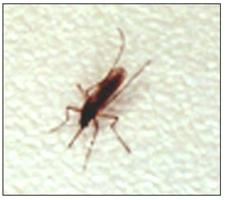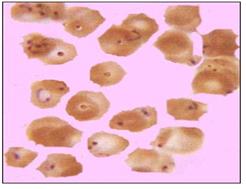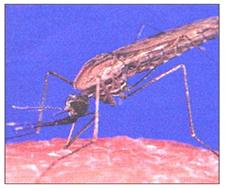말라리아, Malaria
(You may visit www.drleepediatrics.com – Volume 7,
Pediatric Adolescent Infectious Diseases or제 7권, 소아 청소년 감염병 질환 웹사이트)
말라리아의 개요와 원인
-
말라리아는 말라리아 원충을 보균한 아노펠리즈 속 암컷 모기(학질모기)에 물린 후 발생되는 일종의 원충 감염병이다.
-
말라리아를 학질 또는 하루거리라고 부르기도 한다.
-
이 병은 아노펠리즈 속 모기가 서식하는 지역 – 아프리카 사하라지역, 파푸아 뉴기니, 아이티, 인도, 동남아, 라틴 아메리카 등 열대지역에서 주로 발생된다.
-
요즘 그 지역에서 사는 주민들뿐만 아니라 말라리아 원충을 보균한 사람들이 세계 각처로 여행하기 때문에 이 종류의 말라리아는 세계 어디서든지 발견된다.
-
또 여행지에서 말라리아 원충을 보균한 사람을 문 모기가 그 지역에서 사는 주민을 물 때 그 주민에게 말라리아가 생길 수 있고, 말라리아 원충 보균자의 피를 수혈 받은 사람에게도 말라리아가 발생할 수 있다.
-
말라리아를 앓고 있는 임신부로부터 감염되어 태아가 말라리아에 걸릴 수 있고 그로 인해 태아가 유산될 수 있다. 일부는 선천성 말라리아에 걸린 채 태어나기도 한다.
-
이런 말라리아를 선천성 말라리아라고 한다.
-
말라리아에는 여러 종류가 있는데 거의가 삼일열 말라리아 원충 감염으로 생긴다(출처: Archives of Pediatrics & Adolescent Medicine, November 2007, p.1062).
-
일반적으로 모기는 반경 1km 정도 한정된 지역 내에서만 산다.
-
그렇지만 말라리아 원충을 보균한 열대지방 모기들이 비행기 등 현대 교통수단을 통해 말라리아가 조금도 유행되지 않았던 지역까지 이동할 수 있고 그런 모기에 물려 얼토당토않은 지역에서 사는 사람들에게도 말라리아가 생길 수 있다.
말라리아의 원인
-
열대열 원충, 삼일열 원충, 난형열 원충, 또는 사일열 원충을 보균한 아노펠리즈 속 암컷 모기에 물리면 말라리아에 걸릴 수 있다.
-
열대열 원충과 삼일열 원충으로 인한 말라리아가 세계적으로 가장 흔하다.
말라리아의 종류
1. 열대열 원충(Plasmodium falciparum)으로 인한 악성 말라리아
2. 삼일열 원충(Plasmodium vivax)으로 인한 삼일열 말라리아
3. 난형열 원충(Plasmodium ovale)으로 인한 말라리아
4. 사일열 원충(Plasmodium malariae)으로 인한 사일열 말라리아 등 여러 종류의 말라리아가 있다.
말라리아가 유행되는 지역
-
삼일열 원충으로 인한 삼일열 말라리아는 인도, 중앙 아메리카, 남아시아, 동남아시아, 오세아니아, 남미의 일부 지역.
-
열대열 원충으로 인한 악성 말라리아는 아프리카, 아이티, 파푸아 뉴기니, 남 아시아, 동남아시아, 오세아니아, 남미의 일부 지역.
-
사일열 원충으로 인한 사일열 말라리아는 드물게 발생되지만 전세계 광범위한 지역.
-
난형열 원충으로 인한 말라리아는 서아프리카 지역에서 주로 발생되나 그 외 지역에서도 발생된다.
말라리아의 증상 징후

사진 6-6. 보통 모기 사진
아노펠레스모기(Anopheles mosquito)에 물리면 말라리아에 걸릴 수 있다.
Copyright ⓒ 2011 John Sangwon Lee, MD., FAAP

사진 6-7.말라리아 원충의 영양형이 적혈구 내에 있는 것을 현미경을 통해 육안으로 보고 진단할 수 있다. 여기서 파란점으로 나타나 있는 것이 영양형이 다.
Copyright ⓒ 2011 John Sangwon Lee, MD., FAAP

사진 6-8. 아노펠레스 감비애 모기
말라리아 원충을 감염시키는 모기. 출처–미 CDC
-
전 세계적으로 연간 약 350~500만 명이 말라리아를 앓고 1.5~2.7백만 명이 말라리아로 사망한다.
-
미국에서는 약 1,000명의 말라리아 환자가 매년 발생된다.
-
저자도 최근에 아프리카를 다녀온 영아가 말라리아를 앓는 것을 진단 치료했다.
-
소아들이 말라리아에 걸리면 심하게 앓고 특히 열대열 원충으로 인한 말라리아에 걸렸을 때 적절히 치료하지 않으면 생명을 잃을 수 있다.
-
말라리아의 종류에 따라 고열이 하루걸러 또는 3일 걸러 주기적으로 또는 지속적으로 날 수 있다.
-
한전, 땀, 두통 등의 증상 징후가 발작적으로 생길 수 있고 구토, 구기, 설사, 관절통, 복통, 등통, 창백 등의 증상 징후와 용혈성 빈혈, 헤모글로빈 뇨증, 황달 등이 나타날 수 있다.
-
경련, 혼동, 혼수, 저혈당증, 호흡기 부전증, 신진대사성 산혈증, 신장 부전증, 쇼크 등이 생길 수 있다.
-
간과 지라가 비대될 수 있다.
-
뇌염, 장염, 폐렴 등이 생길 수 있다.
-
삼일열 원충 감염으로 인한 삼일열 말라리아나 난형열 원충 감염으로 인한 말라리아를 앓는 영유아들은 말라리아 원충에 감염된 후 8~15일 정도 되면 보채고, 식욕이 상실되고 별 이유를 찾을 수 없이 잘 울고 잠을 너무 많이 자거나 수면장애를 일으킬 수 있다.
-
열대열 원충 감염으로 인한 악성 말라리아를 적절히 치료하지 않으면 호흡기계, 소화기계, 비뇨기계 등 신체 각 계통에 이상이 심하게 생겨 사망하는 것이 보통이다.
-
임신 중 말라리아에 걸리면 유산되거나 조산될 수 있고 태어난 아기에게 선천성 말라리아가 생길 수 있다.
말라리아의 진단
-
병력, 증상 징후, 진찰 소견 등을 종합해서 이 병이 의심되면 혈액검사를 해서 적혈구 내에 있는 말라리아 원충을 현미경검사로 보고 진단한다.
말라리아의 치료
-
말라리아의 종류와 증상 징후, 중증도에 따라 항 말라리아 약물치료와 대증 치료로 치료한다.
-
열대열 원충 감염으로 인한 악성 말라리아를 앓으면 근본적으로 병원 입원치료를 하고 그 외 다른 종류의 말라리아를 앓을 때도 증상, 중증도에 따라 입원치료를 해야 할 때도 있다.
-
열대열 원충 감염으로 인한 악성 말라리아는 Chloroquine, Hydroxychloroquine 또는 Quinine sulfate로 치료하든지 그런 약으로 치료가 되지 않을 때, 또는 치료가 되지 않는다고 추정할 때는 Pyrimethamine, Sulfadoxime, Sulfalen과 Mefloquine 등으로 치료한다.
-
삼일열 원충 감염으로 인한 삼일열 말라리아나 난형열 원충 감염으로 인한 말라리아는 Primaquine제로 치료한다.
-
같은 종류의 약으로 그 말라리아를 예방적 치료를 할 수 있다(표1-4 기생충 감염 치료 참조).
말라리아의 예방
-
말라리아가 유행하는 지역으로 여행을 떠나기 전에 여행 가는 지역이나 나라의 대사관에 연락해 말라리아 예방적 치료에 관한 정보를 얻는다.
-
말라리아 원충을 보균한 모기가 서식하는 지역에 여행갈 때는 여행가기 1주 전부터 다음 말라리아 예방적 약물들 중 1~2가지를 의사의 처방에 따라 복용하기 시작하고 여행 중 그리고 여행지에서 뒤돌아 온 이후 4주 동안 복용해야 한다.
-
Doxycycline으로 예방적 치료를 할 때는 여행 떠나기 1~2일 전에 복용하기 시작하는 것이 보통이다.
-
말라리아 예방적 치료에 쓰는 약에는 Chlorgunide, Pyrimethamine, Chloroquine Disphosphate and Sulfate chlorgunide와 Dapsone, Doxycycline, Sulfadoxime과 Sulfalen, Mefloquine, Proguanil, Atovaquone 등이 있다.
-
일반적으로 Chloroquine으로 말라리아를 예방할 때가 많으나 Chloroquine에 죽지 않는 열대열 원충으로 인한 말라리아를 예방적 치료를 하기 위해서는 Mefloquine제로 예방적 치료를 하는 것을 권장한다.
-
Mefloquine으로 예방적 치료를 할 수 없는 경우는 Chloroquine이나 Chloroquine과 Proguanil로 예방적 치료를 한다.
-
이런 종류의 약으로 예방적 치료를 할 때 약의 부작용이 생길 수 있고 또 예방적 치료하는 방법이 시시각각으로 변할 수 있으므로 의사의 지시에 따라, 또는 여행가는 여행지에 관련된 대사관이나 영사관에 문의해서 결정한다.
-
모기에 물리지 않게 살충제나 모기 구제약을 바르고 모기장을 치고 잔다.
-
모기를 쫓는 DEET 구제제(방충제)를 옷과 몸에 발라 모기에 물리지 않게 해서 말라리아를 예방한다.
-
긴소매가 달린 옷과 긴바지를 입고 모자를 써서 말라리아 원충을 보균한 모기에 물릴지 않게 해서 말라리아를 예방한다.
-
Chloroquine로 치료되지 않는 삼일열 원충으로 인한 삼일열 말라리아가 인도네시아, 파푸아 뉴기니, 솔로몬 섬, 미얀마 등에서 보고되었다. 말라리아 백신이 재발됐으나 아직 실용적 단계에 있지 않다.
Malaria 말라리아
Malaria overview and causes
• Malaria is a type of protozoal infectious disease that occurs after being bitten by a female mosquito of the genus Anofellis carrying the protozoal malaria.
• Malaria is sometimes referred to as haggling or day trip.
• This disease occurs mainly in tropical regions such as the Sahara region of Africa, Papua New Guinea, Haiti, India, Southeast Asia, and Latin America where mosquitoes of the genus Anofellis live.
• Nowadays, this type of malaria is found everywhere in the world because not only residents living in the area but also people carrying the malaria parasite travel around the world.
• In addition, when a mosquito bites a resident who lives in the area when a mosquito bites a person who has a protozoal malaria while traveling, malaria may occur in the resident, and even in a person who has received blood transfusions of a protozoal malaria.
• Infection from a pregnant woman with malaria can cause the fetus to get malaria, which can lead to a miscarriage. Some are born with congenital malaria.
• This malaria is called congenital malaria.
• There are several types of malaria, most of which are caused by triday fever malaria protozoal infection (Source: Archives of Pediatrics & Adolescent Medicine, November 2007, p.1062).
• In general, mosquitoes live only within a limited radius of 1 km.
• Nevertheless, tropical mosquitoes carrying protozoal malaria can travel to areas where malaria has never been prevalent by modern means of transportation, such as airplanes, and malaria can also develop in people living in unpretentious areas from such mosquito bites. Causes of malaria
• If bitten by female mosquitoes of the genus Anophelis carrying tropical fever protozoa, triday fever protozoa, ovoid fever protozoa, or monofilament protozoa, malaria can occur.
• Malaria caused by protozoa and triniotic protozoa is the most common in the world. Types of malaria
1. Malignant malaria caused by Plasmodium falciparum
2. Tri-day fever malaria caused by Plasmodium vivax
3. Malaria caused by Plasmodium ovale
4. There are several types of malaria, such as silt malaria caused by Plasmodium malariae. Malaria epidemic area
• Tri-day-fever malaria caused by protozoa is in India, Central America, South Asia, Southeast Asia, Oceania, and some parts of South America.
• Malaria caused by tropical fever protozoa is Africa, Haiti, Papua New Guinea, South Asia, Southeast Asia, Oceania, and parts of South America.
• Silent fever malaria caused by parasites is a rare occurrence but in a wide range of regions around the world.
• Malaria caused by ovarian fever protozoa occurs mainly in West Africa, but also occurs in other regions. Signs of symptoms of malaria

Photo 6-6. Ordinary mosquito pictures Anopheles mosquito bites can lead to malaria. Copyright ⓒ 2011 John Sangwon Lee, MD., FAAP

Photo 6-7. It is possible to diagnose the malaria protozoa’s vegetative type in red blood cells by visually viewing it through a microscope. Here, the vegetative type is indicated by a blue dot. Copyright ⓒ 2011 John Sangwon Lee, MD., FAAP

Photo 6-8. Anopheles Gambia mosquito Mosquitoes that infect protozoal malaria. Source-US CDC
• Worldwide, about 3.5 to 5 million people suffer from malaria annually, and 1.5 to 2.7 million people die of malaria annually.
• About 1,000 malaria cases occur each year in the United States.
]• The author also diagnosed and treated malaria in infants who recently visited Africa.
• Malaria in children is severely ill and can die if not properly treated, especially malaria caused by tropical fever protozoa.
• Depending on the type of malaria, fever may occur periodically or continuously every other day or every 3 days.
• Symptoms such as KEPCO, sweat, and headache may be seizure, and symptoms such as vomiting, goji, diarrhea, joint pain, abdominal pain, back pain, and paleness, as well as hemolytic anemia, hemoglobinuria, and jaundice may appear.
• Convulsions, confusion, coma, hypoglycemia, respiratory failure, metabolic acidemia, kidney failure, and shock may occur.
• Overlooked spleen may become enlarged.
• Encephalitis, enteritis, and pneumonia may occur.
- Infants and toddlers suffering from malaria due to protozoal trigeminal infection or malaria caused by protozoal ovarian protozoal infection 8 to 15 days after being infected with protozoal parasites, they lose their appetite, cry well for no reason, and sleep too much. You can sleep a lot or cause sleep problems.
• If malaria caused by tropical fever protozoa infection is not properly treated, it is common to die due to severe abnormalities in the respiratory, digestive, and urinary systems.
• Malaria during pregnancy can cause miscarriage or premature delivery, and congenital malaria in babies born. Diagnosis of malaria
• Comprehensive medical history, symptoms, and examination findings. If this disease is suspected, a blood test is performed to diagnose malaria protozoa in red blood cells by microscopic examination.
Malaria treatment
• Depending on the type, symptoms, and severity of malaria, it is treated with antimalarial medications and symptomatic treatment.
• If you suffer from malignant malaria caused by tropical fever protozoa infection, you are basically hospitalized, and even if you suffer from other types of malaria, you may need to be hospitalized depending on your symptoms and severity.
• Malignant malaria caused by tropical fever protozoa infection is treated with Pyrimethamine, Sulfadoxime, Sulfalen and Mefloquine, whether treated with Chloroquine, Hydroxychloroquine, or Quinine Sulfate, or when such drugs are not treated, or when it is assumed that treatment is not possible.
• Triday fever malaria caused by protozoal trigeminal fever infection or malaria caused by ovate protozoal infection is treated with Primaquine.
• The same type of medication can be used to prevent the malaria (see Table 1-4 Parasitic Infection Treatment). Prevention of malaria
• Before taking a trip to an area where malaria is prevalent, contact the embassy of the area or country you are traveling to for information on antimalarial treatment.
• When traveling to an area inhabited by mosquitoes carrying protozoa, start taking one or two of the following antimalarial drugs as prescribed by a doctor from one week before the trip, and four weeks during the trip and after returning from the destination. It should be taken while.
• When taking prophylactic treatment with Doxycycline, it is common to start taking it 1 to 2 days before the trip.
• Medications used to prevent malaria include Chlorgunide, Pyrimethamine, Chloroquine Disphosphate and Sulfate chlorgunide and Dapsone, Doxycycline, Sulfadoxime and Sulfalen, Mefloquine, Proguanil, and Atovaquone.
• In general, Chloroquine is often used to prevent malaria, but to prevent malaria caused by tropical fever protozoa that does not die from Chloroquine, it is recommended to perform prophylactic treatment with Mefloquine.
• If prophylactic treatment with mefloquine is not possible, prophylactic treatment with Chloroquine or Chloroquine and Proguanil is performed.
• When prophylactic treatment with this type of drug may cause side effects of the drug, and the preventive treatment method may change from moment to moment, it is decided according to the doctor’s instructions or by inquiring with the embassy or consulate related to the travel destination. do.
• To avoid mosquito bites, apply insecticide or mosquito repellent and sleep with mosquito nets.
• Prevent malaria by applying mosquito repellent DEET repellent (insect repellent) to your clothes and body to prevent mosquito bites.
• Wear long-sleeved clothing and long pants and a hat to prevent malaria from being bitten by mosquitoes carrying protozoa.
• Triday fever malaria caused by Triday fever protozoa not treated with Chloroquine has been reported in Indonesia, Papua New Guinea, Solomon Island and Myanmar. Malaria vaccine has recurred, but it is not yet in a practical stage (November 2011).
출처 및 참조 문헌 Sources and references
- NelsonTextbook of Pediatrics 22ND Ed
- The Harriet Lane Handbook 22ND Ed
- Growth and development of the children
- Red Book 32nd Ed 2021-2024
- Neonatal Resuscitation, American Academy Pediatrics
- www.drleepediatrics.com제7권. 소아청소년 감염병
- Red book 29th-31st edition 2021
- Nelson Text Book of Pediatrics 19th – 21st Edition
- The Johns Hopkins Hospital, The Harriet Lane Handbook, 22nd edition
-
Childhood Emergencies in the Office, Hospital and Community, American Academy of Pediatrics
-
Emergency Medical Service for Children, By Ross Lab. May 1989. p.10
-
Emergency care, Harvey grant, and Robert Murray
-
Emergency Care Transportation of Sick and Injured American Academy of Orthopaedic Surgeons
-
Emergency Pediatrics A Guide to Ambulatory Care, Roger M. Barkin, Peter Rosen
-
Immediate care of the acutely ill and injured, Hugh E. Stephenson, Jr
-
The Critically Ill Child, Diagnosis and Management, Edited by Clement A. Smith
-
Emergency Medical Services for Children: The Role of the Primary Care Provider, America Academy of Pediatrics
-
Quick Reference To Pediatric Emergencies, Delmer J. Pascoe, M.D., Moses Grossman, M.D. with 26 contributors
-
Manual of Emergency Care
-
응급환자관리 정담미디어
-
소아가정간호백과–부모도 반의사가 되어야 한다, 이상원
-
Neonatal Resuscitation American heart Association
-
Neonatology Jeffrey J.Pomerance, C. Joan Richardson
-
Pediatric Resuscitation Pediatric Clinics of North America, Stephen M. Schexnayder, M.D.
-
Pediatric Critical Care, Pediatric Clinics of North America, James P. Orlowski, M.D.
-
Preparation for Birth. Beverly Savage and Dianna Smith
- Infectious disease of children, Saul Krugman, Samuel L Katz, Ann A. Gershon, Catherine Wilfert
-
The Harriet Lane Handbook 19th Edition
-
소아과학 대한교과서
-
제1권 소아청소년 응급의료 참조문헌과 출처
-
Other
Copyright ⓒ 2015 John Sangwon Lee, MD., FAAP
“부모도 반의사가 되어야 한다”-내용은 여러분들의 의사로부터 얻은 정보와 진료를 대신할 수 없습니다.
“The information contained in this publication should not be used as a substitute for the medical care and advice of your doctor. There may be variations in treatment that your doctor may recommend based on individual facts and circumstances. “Parental education is the best medicine.”